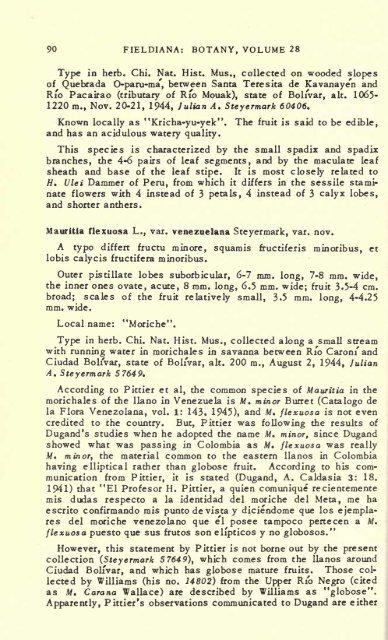PDF - University Library
PDF - University Library
PDF - University Library
You also want an ePaper? Increase the reach of your titles
YUMPU automatically turns print PDFs into web optimized ePapers that Google loves.
90 FIELDIANA: BOTANY, VOLUME 28<br />
Type in herb. Chi. Nat. Hist. Mus., collected on wooded slopes<br />
of Quebrada O-paru-ma, between Santa Teresita de Kavanayen and<br />
Rio Pacairao (tributary of Rio Mouak), state of Bolivar, alt. 1065-<br />
1220 m., Nov. 20-21, 1944, Julian A. Steyermark 60406.<br />
Known locally as "Kricha-yu-yek". The fruit is said to be edible,<br />
and has an acidulous watery quality.<br />
This species is characterized by the small spadix and spadix<br />
branches, the 4-6 pairs of leaf segments, and by the maculate leaf<br />
sheath and base of the leaf stipe. It is most closely related to<br />
H. Ulei Dammer of Peru, from which it differs in the sessile staminate<br />
flowers with 4 instead of 3 petals, 4 instead of 3 calyx lobes,<br />
and shorter anthers.<br />
Mauritia flexuosa L., var. venezuelana Steyermark, var. nov.<br />
A typo differt fructu minore, squamis fructiferis minoribus, et<br />
lobis calycis fructifera minoribus.<br />
Outer pistillate lobes suborbicular, 6-7 mm. long, 7-8 mm. wide,<br />
the inner ones ovate, acute, 8 mm. long, 6.5 mm. wide; fruit 3.5-4 cm.<br />
broad; scales of the fruit relatively small, 3.5 mm. long, 4-4.25<br />
mm. wide.<br />
Local name:<br />
"Moriche".<br />
Type in herb. Chi. Nat. Hist. Mus., collected along a small stream<br />
with running water in morichales in savanna between Rio Carom' and<br />
Ciudad Boli'var, state of Boli'var, alt. 200 m., August 2, 1944, Julian<br />
A. Steyermark 57649.<br />
According to Pittier et al, the common species of Mauritia in the<br />
morichales of the llano in Venezuela is M. minor Burret (Catalogo de<br />
la Flora Venezolana, vol. 1: 143. 1945), and M. flexuosa is not even<br />
credited to the country. But, Pittier was following the results of<br />
Dugand's studies when he adopted the name M. minor, since Dugand<br />
showed what was passing in Colombia as M. flexuosa was really<br />
M. minor, the material common to the eastern llanos in Colombia<br />
having elliptical rather than globose fruit. According to his communication<br />
from Pittier, it is stated (Dugand, A. Caldasia 3: 18.<br />
1941) that "El Profesor H. Pittier, a quien comunique recientemente<br />
mis dudas respecto a la identidad del moriche del Meta, me ha<br />
escrito confirmando mis punto de vista y diciendome que los ejemplares<br />
del moriche venezolano que e'l posee tampoco pertecen a M.<br />
flexuosa puesto que sus frutos son elipticos y no globosos."<br />
However, this statement by Pittier is not borne out by the present<br />
collection (Steyermark 57649), which comes from the llanos around<br />
Ciudad Bolivar, and which has globose mature fruits. Those collected<br />
by Williams (his no. 14802) from the Upper Rib Negro (cited<br />
as M. Carana Wallace) are described by Williams as "globose".<br />
Apparently, Pittier's observations communicated to Dugand are either










![Novellen [microform] - University Library](https://img.yumpu.com/21939450/1/171x260/novellen-microform-university-library.jpg?quality=85)
![Anecdota Chisiana de re metrica [microform]](https://img.yumpu.com/21939448/1/190x239/anecdota-chisiana-de-re-metrica-microform.jpg?quality=85)



![Schollenbruch [microform] : Gedichte - University Library](https://img.yumpu.com/21939437/1/174x260/schollenbruch-microform-gedichte-university-library.jpg?quality=85)
